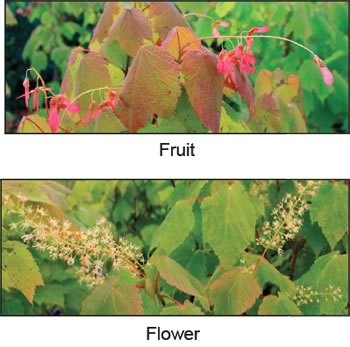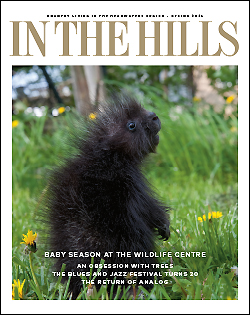Mountain Maple
The sap can be used as a drink or boiled down to make maple syrup.
Acer spicatum aka mountain maple, dwarf maple, moose maple. Unmistakable Canadian maple leaves. The sap can be used as a drink or boiled down to make maple syrup. Important plant for preventing erosion on stream banks and steep slopes. Spreading branches become buried in leaf litter where they put down roots and send up new shoots. Attracts pollinators.
Mountain Maple Characteristics
 Leaves: Dark yellowish green in summer changing to yellow, orange and red in fall.
Leaves: Dark yellowish green in summer changing to yellow, orange and red in fall.
Stem/Bark: Bark is thin brownish or grayish brown. Young stems are grayish developing to purplish red or often greenish on one side, coated with very short grey hairs.
Flower: Yellow, green-brown in dense upright clusters 3″- 6″ long at branchlet tips in May-June.
Fruit/Nut: Samaras (often called helicopter or key) are brilliant red or red-brown.
Habit: Bushy short-trunked tree.
Hardiness: Zone 3
Height: 10’ – 30’
Width: 0 – 15’
Why grow native plants?
A native plant is defined as a species of fauna that was already established before colonization. There are numerous benefits to the use of Native Plants. Native plants have grown and evolved in a given area for generations and therefore are more prepared to face the elements. As a result they are much hardier and less finicky to care for. The wildlife in the area has also evolved along side these plants, and because of this has formed bonds with them. Most butterflies have a specific plant species from which they collect nectar for their offspring. There are many birds that will feed directly from local trees for seed, nectar or fruit, but won’t use the bird feeder you’ve bought to attract them. These plants also work together to grow as natural plant communities. Most of the trees won’t grow their leaves until after the wildflowers have had an adequate amount of time to flower before they’re covered by shade. Finally, of course, there is the fact that all of these plants and animals combine to make a sustainable, complete, functioning ecosystem. Why fight thousands of years of evolution?
Have questions about native plants? Post a comment Ian will get back to you.






